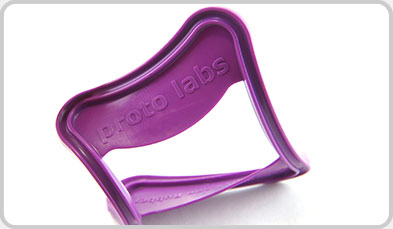 |
| March 25, 2014 | Volume 10 Issue 12 |
Designfax weekly eMagazine
Archives
Partners
Manufacturing Center
Product Spotlight
Modern Applications News
Metalworking Ideas For
Today's Job Shops
Tooling and Production
Strategies for large
metalworking plants
Real LSR parts really fast:
Proto Labs launches advanced liquid silicone rubber injection molding; provides valuable design tips
Proto Labs is officially kicking off its new, advanced liquid silicone rubber injection molding service at the Boston Convention & Expo Center, March 26-27, 2014 (booth #654). Liquid silicone rubber (LSR) is a thermoset engineering material that is particularly suitable for applications in the medical sector: It can withstand sterilization and is biocompatible, so it works well for products that have skin contact. With this offering, Proto Labs brings a practical and cost-effective way to get real LSR parts really fast (as fast as five business days!). The company also offers some super-valuable design tips in this article.

LSR molding is a great process for producing pliable, durable parts.
Vicki Holt, president and CEO of Proto Labs, says that the new offering "allows current and future customers more diversity in prototyping -- something every product developer can appreciate."
Users of the Protomold Injection Molding Service simply upload a 3D CAD model via a secure website and receive an interactive quote within one business day, accompanied by a geometrical analysis of the part and full manufacturability analysis. Quantities from just 25 to 5,000+ parts can be shipped in less than three weeks, and depending on complexity, as fast as five business days.
More about LSR and its design considerations
LSR molding shares many similarities with conventional injection molding, but there are a few notable differences. Unlike thermoplastic resin, which is melted before injection, LSR is a two-part thermoset compound that is chilled, before being injected into a heated mold and ultimately cured into a final part. Since LSR is a thermosetting polymer, its molded state is permanent -- once it is set, it can't be melted again like a thermoplastic.
LSR has certain inherent characteristics. It is a strong, elastic material with excellent thermal, chemical, and electrical resistance. LSR parts also maintain their physical properties at extreme temperatures. These benefits lend themselves well to automotive, medical, and food appliance industries, typically in the form of seals, gaskets, valves, and cables.
Designing parts for LSR and thermoplastics are similar, but there are some LSR-specific guidelines to consider:
- Size: Parts with a maximum size of approximately 5 in. by 5 in. by 2 in. can be uploaded. For larger parts, users should contact Proto Labs to discuss possible options.
- Wall and rib thickness: LSR typically fills thin wall sections with minimal challenges, and walls as thin as 0.010 in. are possible, depending on the size of the wall and the location of adjacent thicker sections. Rib thickness should be 0.5 to 1.0 times the adjoining wall thickness. LSR is accommodating to variations in wall thickness, and sink is almost nonexistent.
- Shrink and flash: The shrink rate on LSR is fairly high with an expected tolerance of 0.025 in./in. LSR also tends to flash very easily during molding (in gaps as small as 0.0002 in.), which Protomold helps reduce by incorporating additional features into the mold design.
- Parting lines: Simplifying and minimizing parting lines in your design will help you get cleaner LSR parts as quickly as possible.
- Undercuts: LSR can be molded to accommodate parts with undercuts, which are manually removed by a press operator. Mechanical tooling actions to release undercuts are selectively offered at Proto Labs.
- Part ejection: Ejector pins are normally not used during LSR molding due to the flashy nature of the material. Thus, parts should be designed so they can be retained on one-half of the mold when it is opened at the end of the molding cycle. The part is then manually de-molded, often with air assistance.
Liquid Silicone Rubber has been in the industry for a long time; now Protomold offers LSR parts in volumes of 25 to 5,000+ in three weeks or less. To learn more about these new capabilities -- including additional design guidelines on draft, finishes, and more -- check out the company's LSR page. If you have a 3D CAD model ready, upload it now to get an interactive quote with design analysis and pricing information within hours.
For more information, visit www.protolabs.com/rubber-injection-molding/.
Source: Proto Labs/Protomold
Published March 2014
Rate this article
View our terms of use and privacy policy
